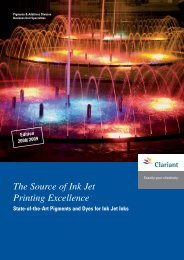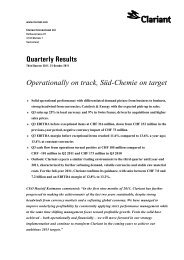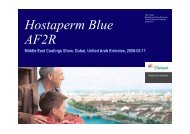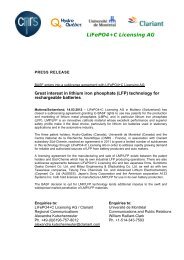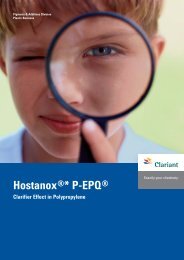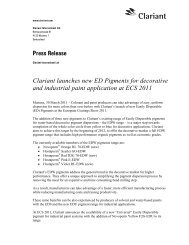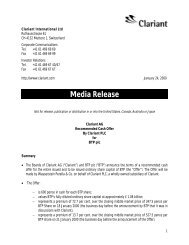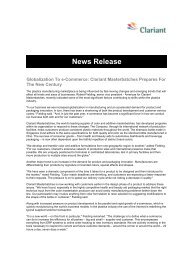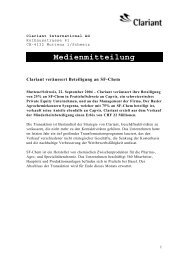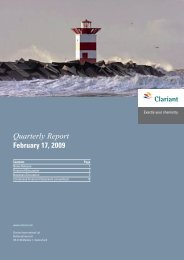Exolit
Exolit
Exolit
Create successful ePaper yourself
Turn your PDF publications into a flip-book with our unique Google optimized e-Paper software.
Pigments & Additives Division<br />
Specialties Business<br />
<strong>Exolit</strong> ® for Polyurethane<br />
Application areas for <strong>Exolit</strong> grades<br />
Exactly your chemistry.
<strong>Exolit</strong> for Polyurethane<br />
Contents<br />
<strong>Exolit</strong> for polyurethane 2<br />
Flame retardants for polyurethane 4<br />
Flexible polyether foam<br />
(slabstock and molded foam) 6<br />
Flexible polyester foam<br />
(slabstock foams) 8<br />
Rigid PU foam 10<br />
Rigid PIR foam 12<br />
Integral skin foam 13<br />
Cast resins 14<br />
2<br />
> Application areas for <strong>Exolit</strong> grades
<strong>Exolit</strong> for polyurethane<br />
With its <strong>Exolit</strong> grades the Pigments<br />
& Additives Division offers an extensive<br />
range of flame retardants for<br />
polyurethane on a non-halogen basis.<br />
The <strong>Exolit</strong> grades exhibit following<br />
characteristics:<br />
<strong>Exolit</strong> in the case of fire<br />
Low smoke gas corrosivity<br />
> Reduced damage of installations<br />
and buildings<br />
Low smoke density<br />
> Extended escape time<br />
<strong>Exolit</strong>-compatibility<br />
Highly effective, low dosage,<br />
high polymer compatibility<br />
> Only slight influence on mechanical<br />
properties<br />
Excellent incorporation into matrix<br />
> No migration<br />
Good recyclability of FR-Polyurethanes<br />
> Meet current and future consumer<br />
recycling requirements<br />
<strong>Exolit</strong>-in final product<br />
Excellent ageing stability<br />
> Low dosage, no migration, high<br />
quality during life cycle<br />
Attractive price/performance ratio<br />
> Competitive systems<br />
Optimal emission behaviour<br />
> Minimization of the exposition risk<br />
of volatile organic compounds (VOC)<br />
Because of these properties <strong>Exolit</strong><br />
flame retardants contribute to meeting<br />
the customer requirement regarding<br />
environmental impact and image.<br />
Polyurethane systems which incorporate<br />
<strong>Exolit</strong> flame retardants can obtain<br />
the most demanding fire tests, whilst<br />
retaining good mechanical properties.<br />
These features allow the materials to<br />
be used in new and demanding fields<br />
of application.<br />
3
Flame retardants for polyurethane<br />
Under the brand name <strong>Exolit</strong>, Clariant<br />
supplies non-halogenated environmentally<br />
friendly flame retardants with<br />
an assured future in polyurethane<br />
applications.<br />
Application area Test Description Classification<br />
* = Federal motor vehicle safety standard<br />
4<br />
Their advantage lies in their effectiveness,<br />
which enables very low concentrations<br />
to be used, while at the<br />
same time meeting the most stringent<br />
requirements. In the event of fire<br />
involving <strong>Exolit</strong>-containing systems,<br />
a reduction in smoke density is apparent.<br />
Since no halogen-containing flame<br />
retardants are required, no corrosive<br />
gases such as HCl or HBr are released.<br />
These properties are of great importance<br />
in modern vehicle manufacture.<br />
Automotive FMVSS 302* Flammability SE > SE/NBR > SE/B > B<br />
California Techn. Bulletin 117 Fire resistance<br />
PBT VWT 709 VOC Emission Value<br />
DIN 75201 Fogging characteristics Value<br />
Construction DIN 4102 (Germany) Chimney test B1 > B2<br />
NF P 92-501 (France) Epiradiateur M1 > M2 > M3<br />
Electrical & UL 94 (International) Burning time after ignition V0 > V1 > V2<br />
electronics HF1 > HF2 > HBF
Polyurethane product overview<br />
Products Supply form Flexible polyurethane foams Rigid polyurethane foams PU<br />
Polyether Polyester Integral PUR PIR Integral Casting/<br />
skin skin moulding<br />
<strong>Exolit</strong> AP 422 White powder<br />
<strong>Exolit</strong> AP 462 White powder<br />
<strong>Exolit</strong> AP 750 White powder<br />
<strong>Exolit</strong> OP 550 Medium-viscosity liquid<br />
<strong>Exolit</strong> OP 560 Medium-viscosity liquid<br />
<strong>Exolit</strong> RP 6520 Red thixotropic dispersion<br />
<strong>Exolit</strong> RP 6580 Red thixotropic dispersion<br />
5
Flexible polyether foam (slabstock and molded foam)<br />
Advantages of <strong>Exolit</strong>:<br />
> Liquid reactive,<br />
incorporable flame retardants<br />
> Low migration<br />
> Low emissions (e.g. low<br />
fogging and VOC-values)<br />
> High flame retardant efficiency<br />
through product life cycle<br />
> Only slight influence on<br />
mechanical foam properties<br />
> Usable in conventional production<br />
facilities by adding directly at<br />
the mixing head<br />
> Good performance in flame<br />
laminating processing (low smoke<br />
emission, good adhesion)<br />
> In the case of fire,<br />
low smoke gas corrosiveness<br />
6<br />
(mg)<br />
16<br />
12<br />
8<br />
4<br />
0<br />
TCPP 1) TDCPP 2) Cl-<br />
Diphosphate<br />
3)<br />
<strong>Exolit</strong><br />
OP 550<br />
Figure 2: DIN 75201: Fogging condensates of flexible polyether foams<br />
containing 7.5 php flame retardant.<br />
1) = Tris(chloroisopropyl)phosphate<br />
2) = Tris(dichloroisopropyl)phosphate<br />
3) = Tetrakis(2-Chloroethyl)dichloroisopentyldiphosphate<br />
<strong>Exolit</strong><br />
OP 560<br />
1mg<br />
(php)<br />
20<br />
15<br />
10<br />
5<br />
0<br />
22.5 25.0 27.5 30.0 32.5 35.0<br />
Foam Density (kg/m 3 )<br />
Figure 1: MVSS 302: Minimum FR levels to achieve class SE of flexible polyether<br />
foams at different foam densities.<br />
(ppm)<br />
350<br />
300<br />
250<br />
200<br />
150<br />
100<br />
50<br />
0<br />
Cl-<br />
Diphosphate<br />
3)<br />
<strong>Exolit</strong> OP 550 TDCPP 2)<br />
<strong>Exolit</strong><br />
OP 550<br />
<strong>Exolit</strong><br />
OP 560<br />
Figure 3: VOC-Emissions of flexible polyether foams containing 6 php flame retardant,<br />
head space examination (5 h / 120 °C).
Products<br />
<strong>Exolit</strong> OP 550 Liquid, medium viscosity, reactive phosphorus polyol (functionality approx. 2)<br />
<strong>Exolit</strong> OP 560 Liquid, medium viscosity, reactive phosphorus polyol (functionality approx. 2)<br />
Application area Classification Addition rate<br />
Automotive FMVSS 302 2-10 parts of <strong>Exolit</strong> OP 550 or<br />
Class SE OP 560/100 parts polyol<br />
DIN 75201 2-10 parts of <strong>Exolit</strong> OP 550 or<br />
(Fogging-test G) with
Flexible polyester foam (slabstock foams)<br />
Advantages of <strong>Exolit</strong>:<br />
> No emissions<br />
(e.g. low fogging and VOC-values)<br />
> Solid easily dispersible in polyol<br />
(<strong>Exolit</strong> AP)<br />
> Usable in conventional production<br />
facilities by adding directly into the<br />
mixing head (<strong>Exolit</strong> OP)<br />
Products<br />
> Highly effective<br />
> Only slight influence on<br />
mechanical properties<br />
> No contribution to corrosive<br />
gases in the case of fire<br />
> Reduced foam dripping<br />
in the case of fire (<strong>Exolit</strong> AP)<br />
<strong>Exolit</strong> AP 422 White powder D50 15 µm, standard product<br />
<strong>Exolit</strong> AP 462 White powder D50 20 µm, microencapsulated for moisture sensitive applications<br />
<strong>Exolit</strong> OP 560 Liquid, medium viscosity, reactive phosphorus polyol (functionality approx. 2)<br />
Application area Classification Addition rate<br />
Construction DIN 4102 8-10 parts <strong>Exolit</strong> AP 422 in combination<br />
Class B2 with 8-10 parts <strong>Exolit</strong> OP 560 /<br />
100 parts polyol<br />
Automotive FMVSS 302 5-10 parts <strong>Exolit</strong> AP 422 or 2-10 parts<br />
Class SE <strong>Exolit</strong> OP 560/100 parts polyol<br />
DIN 75201 G (no fogging) 5-10 parts <strong>Exolit</strong> AP 422/100 parts polyol<br />
DIN 75201 G < 1 mg 2-10 parts <strong>Exolit</strong> OP 560/100 parts polyol<br />
PBT VWT 709<br />
no VOC or FOG contribution<br />
5-10 parts <strong>Exolit</strong> AP 422/100 parts polyol<br />
Electrical UL 94 10-20 parts <strong>Exolit</strong> AP 422/<br />
Class HF1 100 parts polyol<br />
The addition rate to achieve a specific fire classification depends heavily on the polyol, blowing agent and foam density.<br />
8
(ppm)<br />
350<br />
300<br />
250<br />
200<br />
150<br />
100<br />
50<br />
0<br />
TDCPP 1)*<br />
(8 php)<br />
<strong>Exolit</strong> OP 560<br />
(4 php)<br />
Figure 4: PBT VWT 709: Emission behaviour of flexible polyester foams<br />
in fire classification SE (FMVSS 302).<br />
1) = Tris(dichloroisopropyl)phosphate<br />
* = Federal motor vehicle safety standard<br />
<strong>Exolit</strong> AP 422<br />
(9 php)<br />
VOC FOG<br />
no FR<br />
9
Rigid PU foam<br />
Advantages of <strong>Exolit</strong> AP:<br />
> Enables non-halogenated,<br />
pentane based DIN 4102 B2<br />
formulations<br />
> Easily dispersible in polyols<br />
> Perfectly incorporated<br />
> No migration, no emissions<br />
> Only slight influence on<br />
mechanical foam properties<br />
> Reduced smoke values<br />
10<br />
(DS) Flaming conditions<br />
250<br />
200<br />
150<br />
100<br />
50<br />
0<br />
1 2 3 4 5 6<br />
Time [min]<br />
halogenated FR <strong>Exolit</strong> AP 422 no FR<br />
CO HCI HCN<br />
Advantages of <strong>Exolit</strong> RP:<br />
> Highly efficient<br />
> Meet high requirements<br />
halogenated FR<br />
no Fr<br />
<strong>Exolit</strong> AP 422<br />
Figure 5: NBS Smoke chamber (ASTM-E 662): Specific optical smoke densities of burning rigid, n-pentane based DIN 4102 B2 foams<br />
(ppm) Smoke gas analysis<br />
200<br />
180<br />
160<br />
140<br />
120<br />
100<br />
80<br />
60<br />
40<br />
20<br />
0<br />
Figure 6: NBS Smoke chamber (ASTM-E 662): Combustion gas analysis of burning rigid,<br />
n-pentane based DIN 4102 B2 foams (flaming conditions)<br />
(DS) Smoldering conditions<br />
100<br />
80<br />
60<br />
40<br />
20<br />
0<br />
Advantages of <strong>Exolit</strong> OP:<br />
> Liquid, reactive (graftable)<br />
phosphorus polyol<br />
> Compatible with conventional<br />
production equipment by adding<br />
directly into the mixing head<br />
halogenated FR<br />
1 2 3 4 5 6<br />
Time [min]<br />
no Fr<br />
<strong>Exolit</strong> AP 422
Products<br />
<strong>Exolit</strong> AP 422 White powder D 50 15 µm, standard product<br />
<strong>Exolit</strong> AP 462 White powder D 50 20 µm, microencapsulated for moisture sensitive applications<br />
<strong>Exolit</strong> OP 550 Liquid, medium viscosity, reactive phosphorus polyol (functionality approx. 2)<br />
<strong>Exolit</strong> OP 560 Liquid, medium viscosity, reactive phosphorus polyol (functionality approx. 2)<br />
<strong>Exolit</strong> RP 6520 Red thixotropic dispersion of highly stabilized red phosphorus, carrier: castor oil<br />
<strong>Exolit</strong> RP 6580* Red thixotropic dispersion of highly stabilized red phosphorus, carrier: TCPP<br />
Application area Classification Addition rate<br />
Construction DIN 4102 15-50 parts of <strong>Exolit</strong> AP 422<br />
Class B2 or AP 462/100 parts of polyol<br />
(depending on the polyols and<br />
blowing agents used)<br />
DIN 4102 15-30 parts of <strong>Exolit</strong> OP 550<br />
Class B2 or OP 560/100 Parts of polyol<br />
(depending on the polyols and<br />
blowing agents used)<br />
DIN 4102 10-30 parts of <strong>Exolit</strong> RP 6520<br />
Class B2 or RP 6580/100 parts of polyol<br />
(additional parts of TCPP are<br />
depending on the systems used)<br />
The addition rate to achieve a specific fire classification depends heavily on the polyol, blowing agent and foam density.<br />
* = Contains halogen<br />
11
Rigid PIR foam<br />
Advantages of <strong>Exolit</strong> AP:<br />
> Easily dispersable in polyols<br />
> Perfectly incorporated<br />
> No migration, no emissions<br />
> Only slight influence on<br />
mechanical foam properties<br />
> Reduced smoke values<br />
Products<br />
12<br />
Advantages of <strong>Exolit</strong> RP:<br />
> Highly efficient<br />
> Meets high requirements<br />
(e.g. DIN 4102 B1)<br />
<strong>Exolit</strong> AP 422 White powder D50 15 µm, standard product<br />
<strong>Exolit</strong> AP 462 White powder D50 20 µm, microencapsulated for moisture sensitive applications<br />
<strong>Exolit</strong> RP 6580 Red thixotropic dispersion of highly stabilized red phosphorus, carrier: TCPP<br />
Application area Classification Addition rate<br />
Construction DIN 4102 5-10 parts <strong>Exolit</strong> AP 422 /<br />
Class B2 100 parts polyol (blowing agent<br />
pentane, NCO index 250, combined<br />
with other non-halogenated liquid<br />
flame retardants)<br />
Class B1 15 parts <strong>Exolit</strong> RP 6580/100 parts<br />
polyol (blowing agent R 141b,<br />
high NCO index combined with<br />
additional TCPP)<br />
NF P 92-501 10-15 parts <strong>Exolit</strong> RP 6580/100 parts<br />
Class M1 polyol (blowing agent R 141b,<br />
high NCO index combined with<br />
additional TCPP)<br />
The addition rate to achieve a specific fire classification depends heavily on the polyol, blowing agent and foam density.
Integral skin foam<br />
Advantages of the <strong>Exolit</strong> AP:<br />
> Fine cell foam structure<br />
> Solid material,<br />
easily dispersible in polyol<br />
> No migration<br />
> Highly effective<br />
> No influence on mechanical<br />
properties<br />
Products<br />
> No plasticizing effects<br />
> Low smoke gas corrosivity in<br />
the case of fire<br />
> No influence on foam recycling<br />
(e.g. on glycolisis)<br />
<strong>Exolit</strong> AP 422 White powder D50 15 µm, standard product<br />
<strong>Exolit</strong> AP 462 White powder D50 20 µm, microencapsulated for moisture sensitive applications<br />
<strong>Exolit</strong> AP 750 White powder, intumescent flame retardant system based on <strong>Exolit</strong> AP 422<br />
<strong>Exolit</strong> RP 6520 Red thixotropic dispersion of highly stabilised red phosphorus, carrier: castor oil<br />
Application area Classification Addition rate<br />
Construction DIN 4102 10-15 parts <strong>Exolit</strong> AP 422 /<br />
Class B2 100 parts polyol,<br />
rigid integral skin foam<br />
Electrical UL 94 10-15 parts <strong>Exolit</strong> AP 422 /<br />
Class 5V 100 parts polyol,<br />
rigid integral skin foam<br />
The extremely demanding requirements of railway and aircraft standards (e.g. DIN 5510, ABD 031)<br />
can be achieved with these highly effective flame retardants in special developed rigid and flexible<br />
integral skin formulations<br />
The addition rate to achieve a specific fire classification depends heavily on the polyol, blowing agent and foam density.<br />
13
Cast resins<br />
Advantages of the systems:<br />
> Low smoke gas corrosiveness<br />
in the case of fire<br />
> Low filler content<br />
> Low processing viscosity and<br />
good flow properties<br />
> <strong>Exolit</strong> RP 6520 does not affect the<br />
electrical properties<br />
14<br />
(php) UL 94 V-0 (1.6 mm)<br />
350<br />
300<br />
250<br />
200<br />
150<br />
100<br />
50<br />
0<br />
ATH ATH + AP 422 ATH + RP 6520<br />
ATH <strong>Exolit</strong> AP 422 <strong>Exolit</strong> RP 6520<br />
Figure 7: Flame retardant concentrations in cast resins: <strong>Exolit</strong> combined with ATH<br />
compared to pure ATH (aluminia trihydrate)
Products<br />
<strong>Exolit</strong> AP 422 White powder D 50 15 µm, standard product<br />
<strong>Exolit</strong> AP 462 White powder D 50 20 µm, microencapsulated for moisture sensitive applications<br />
<strong>Exolit</strong> RP 6520 Red thixotropic dispersion of highly stabilized red phosphorus, carrier: castor oil<br />
Application area Classification Addition rate<br />
Electrical UL 94 10-15 parts <strong>Exolit</strong> AP 422 /<br />
Class V-1, 1.6 mm 100 parts polyol<br />
Class V-0, 1.6 mm 20-30 parts <strong>Exolit</strong> AP 422 combined<br />
with 70-120 parts ATH<br />
Class V-0, 1.6 mm 15-25 parts <strong>Exolit</strong> RP 6520 combined<br />
with 50-100 parts ATH /100 parts polyol<br />
Transportation DIN 5510 25-35 parts <strong>Exolit</strong> AP 422 combined<br />
Class S4 SR2 ST2 with 20 parts <strong>Exolit</strong> RP 6520<br />
and 100 parts ATH<br />
The addition rate to achieve a specific fire classification depends heavily on the polyol, blowing agent and foam density.<br />
15
Please note<br />
This information is based on our present state of knowledge and is intended to provide<br />
general notes on our products and their uses. It should not therefore be construed<br />
as guaranteeing specific properties of the products described or their suitability for<br />
a particular application. Any existing industrial property rights must be observed.<br />
The quality of our products is guaranteed under our General Conditions of Sale.<br />
® = Trademark of Clariant registered in numerous countries<br />
Edition: June 2007<br />
www.pa.clariant.com<br />
www.exolit.com<br />
Clariant International Ltd.<br />
Pigments & Additives Division<br />
Marketing Specialties Business<br />
Rothausstrasse 61<br />
4132 Muttenz<br />
Switzerland<br />
Phone: +41- 61- 469-7974<br />
Fax: +41- 61- 469-7555<br />
Clariant Produkte (Deutschland) GmbH<br />
Pigments & Additives Division<br />
Marketing Flame Retardants<br />
65926 Frankfurt am Main<br />
Germany<br />
Phone: +49-69 -305-18429<br />
Fax: +49-69 -305-17188<br />
Clariant Produkte (Deutschland) GmbH<br />
Pigments & Additives Division<br />
R&D Flame Retardants<br />
Application Technology<br />
50351 Hürth-Knapsack<br />
Germany<br />
Phone: +49- 22 33- 48-6512<br />
Fax: +49- 22 33- 412 36<br />
Exactly your chemistry.<br />
DA 4004 E_06/07





